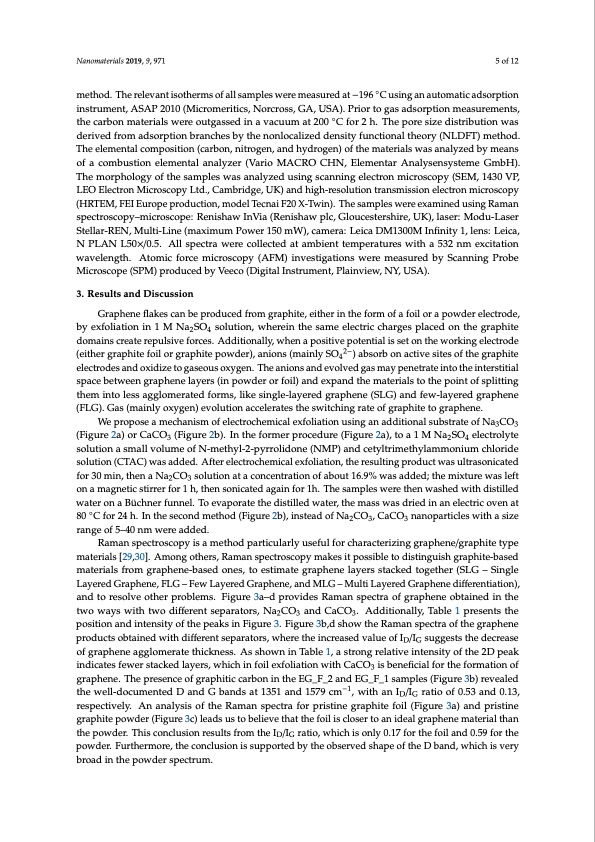PDF Publication Title:
Text from PDF Page: 005
Nanomaterials 2019, 9, 971 5 of 12 method. The relevant isotherms of all samples were measured at −196 ◦C using an automatic adsorption instrument, ASAP 2010 (Micromeritics, Norcross, GA, USA). Prior to gas adsorption measurements, the carbon materials were outgassed in a vacuum at 200 ◦C for 2 h. The pore size distribution was derived from adsorption branches by the nonlocalized density functional theory (NLDFT) method. The elemental composition (carbon, nitrogen, and hydrogen) of the materials was analyzed by means of a combustion elemental analyzer (Vario MACRO CHN, Elementar Analysensysteme GmbH). The morphology of the samples was analyzed using scanning electron microscopy (SEM, 1430 VP, LEO Electron Microscopy Ltd., Cambridge, UK) and high-resolution transmission electron microscopy (HRTEM, FEI Europe production, model Tecnai F20 X-Twin). The samples were examined using Raman spectroscopy–microscope: Renishaw InVia (Renishaw plc, Gloucestershire, UK), laser: Modu-Laser Stellar-REN, Multi-Line (maximum Power 150 mW), camera: Leica DM1300M Infinity 1, lens: Leica, N PLAN L50×/0.5. All spectra were collected at ambient temperatures with a 532 nm excitation wavelength. Atomic force microscopy (AFM) investigations were measured by Scanning Probe Microscope (SPM) produced by Veeco (Digital Instrument, Plainview, NY, USA). 3. Results and Discussion Graphene flakes can be produced from graphite, either in the form of a foil or a powder electrode, by exfoliation in 1 M Na2SO4 solution, wherein the same electric charges placed on the graphite domains create repulsive forces. Additionally, when a positive potential is set on the working electrode (either graphite foil or graphite powder), anions (mainly SO42−) absorb on active sites of the graphite electrodes and oxidize to gaseous oxygen. The anions and evolved gas may penetrate into the interstitial space between graphene layers (in powder or foil) and expand the materials to the point of splitting them into less agglomerated forms, like single-layered graphene (SLG) and few-layered graphene (FLG). Gas (mainly oxygen) evolution accelerates the switching rate of graphite to graphene. We propose a mechanism of electrochemical exfoliation using an additional substrate of Na3CO3 (Figure 2a) or CaCO3 (Figure 2b). In the former procedure (Figure 2a), to a 1 M Na2SO4 electrolyte solution a small volume of N-methyl-2-pyrrolidone (NMP) and cetyltrimethylammonium chloride solution (CTAC) was added. After electrochemical exfoliation, the resulting product was ultrasonicated for 30 min, then a Na2CO3 solution at a concentration of about 16.9% was added; the mixture was left on a magnetic stirrer for 1 h, then sonicated again for 1h. The samples were then washed with distilled water on a Büchner funnel. To evaporate the distilled water, the mass was dried in an electric oven at 80 ◦C for 24 h. In the second method (Figure 2b), instead of Na2CO3, CaCO3 nanoparticles with a size range of 5–40 nm were added. Raman spectroscopy is a method particularly useful for characterizing graphene/graphite type materials [29,30]. Among others, Raman spectroscopy makes it possible to distinguish graphite-based materials from graphene-based ones, to estimate graphene layers stacked together (SLG – Single Layered Graphene, FLG – Few Layered Graphene, and MLG – Multi Layered Graphene differentiation), and to resolve other problems. Figure 3a–d provides Raman spectra of graphene obtained in the two ways with two different separators, Na2CO3 and CaCO3. Additionally, Table 1 presents the position and intensity of the peaks in Figure 3. Figure 3b,d show the Raman spectra of the graphene products obtained with different separators, where the increased value of ID/IG suggests the decrease of graphene agglomerate thickness. As shown in Table 1, a strong relative intensity of the 2D peak indicates fewer stacked layers, which in foil exfoliation with CaCO3 is beneficial for the formation of graphene. The presence of graphitic carbon in the EG_F_2 and EG_F_1 samples (Figure 3b) revealed the well-documented D and G bands at 1351 and 1579 cm−1, with an ID/IG ratio of 0.53 and 0.13, respectively. An analysis of the Raman spectra for pristine graphite foil (Figure 3a) and pristine graphite powder (Figure 3c) leads us to believe that the foil is closer to an ideal graphene material than the powder. This conclusion results from the ID/IG ratio, which is only 0.17 for the foil and 0.59 for the powder. Furthermore, the conclusion is supported by the observed shape of the D band, which is very broad in the powder spectrum.PDF Image | Electro-Exfoliation of Graphite to Graphene

PDF Search Title:
Electro-Exfoliation of Graphite to GrapheneOriginal File Name Searched:
graphene-aqueous-salt-al.pdfDIY PDF Search: Google It | Yahoo | Bing
Salgenx Redox Flow Battery Technology: Power up your energy storage game with Salgenx Salt Water Battery. With its advanced technology, the flow battery provides reliable, scalable, and sustainable energy storage for utility-scale projects. Upgrade to a Salgenx flow battery today and take control of your energy future.
CONTACT TEL: 608-238-6001 Email: greg@infinityturbine.com (Standard Web Page)